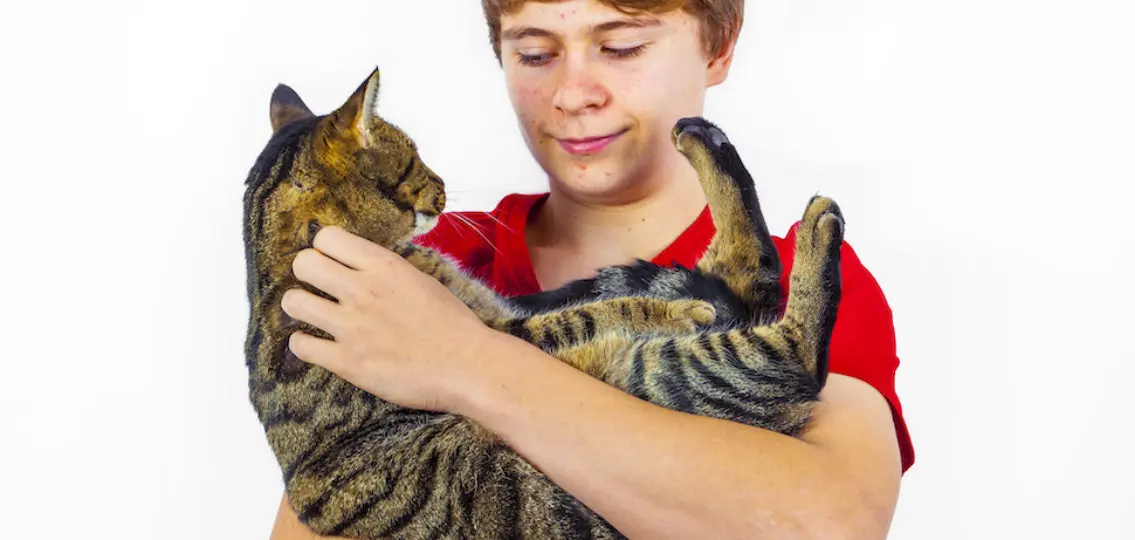Like many other families looking to bring a little joy into their locked-down lives, we adopted a cat at the onset of the pandemic.

This fluffy feline, whom we named Bubbles because of her bright and bubbly green eyes, bore a striking resemblance to the beloved pet we lost to cancer months earlier. Unlike her predecessor, who adored being carried around like a newborn, this kitty didn’t crave attention.
In their excitement at having a new pet, my sons attempted to pick up Bubbles only to have her dart away.
“Don’t chase her,” I scolded them. “She’s telling you she doesn’t want to play. You have to respect that.”
They listened— reluctantly—and I saw this situation as a perfect opportunity to remind my sons about consent and the importance of respecting boundaries.
As a mom of teen boys, these topics are never far from my mind. While we’ve had these discussions before, I’ve often wondered if my words were sinking in. Or, had I become like the adult in a Peanuts cartoon droning on wah-wah-wah-style while they tuned me out? How could I be sure that I was teaching consent and that my boys grasped the importance of this message?
Once Bubbles settled in, she grew comfortable with the occasional head-scratching and chin-rubbing. She was such a great addition that when the rescue organization called to ask if we’d consider adopting a kitten, we quickly agreed. And that’s when the concept of teaching consent transformed from abstract to concrete.
“But She Liked It At First”
As soon as the kitten—named Boots for his snowy white paws—joined the family, he and Bubbles sniffed each other good-naturedly. But as days passed, Boots became bolder, taking swipes at Bubbles’ tail, causing her to back away, startled.
“Oh, she didn’t like that!” my sons observed.
Though just one-third Bubbles’ size, the kitten continued his pawing and pouncing in a way that was part-play, half-aggressive. Initially, Bubbles engaged, but when she’d had enough, she retreated. If the kitten continued his unwanted advances, pursuing her from room to room, she’d hiss.
“But she liked it at first,” my 15-year-old said, confused. “She was having fun. Why does she want to stop?”
His statement caught me off-guard. How many times have we heard or read similar sentiments from frat boys and politicians? I saw this as another opening to teach about the nature of consent and explain that it’s fluid, which means it may change from one moment to the next.
Teaching Teens About Consent
In talking with my sons about this topic, I took some of my cues from Elizabeth L. Jeglic, Ph.D., an expert in sexual violence prevention and professor of psychology at the John Jay College of Criminal Justice. Jeglic explains that when talking to our kids about consent, it’s important to emphasize that it is not a one-time thing.
“Just because you said ‘yes’ to one sexual activity doesn’t mean that you said ‘yes’ to all sexual activities,” she says. “Consent can change during the course of interactions, such that you can initially give your consent, but then you can change your mind.”
It’s also essential to reinforce the concept that just because someone may have given consent in the past, it doesn’t mean that they’ve given consent today.
“Consent should be given for each activity each time,” Dr. Jeglic explains. “It is always best to get verbal consent as it leaves less room for misunderstandings, but you should also observe someone’s body language. For example, sometimes people feel pressured into engaging in sexual behavior even if they really do not want to—so even if they say ‘yes’ if they are not enthusiastic participants or are pushing you away, then you should probably stop.”
Shortly after bringing Boots into our home, we noticed a change in Bubbles. Before entering a room, she paused, keeping an eye out for the frisky kitten. She looked around to make sure she was safe before lowering her head to her food bowl.
“Bubbles seems different,” my kids agreed. “She’s not hanging out with us as much. Does she not feel safe here anymore?”
My sons witnessed how living in an environment where boundaries aren’t respected can negatively impact personality. This was an important point, and one, admittedly, I hadn’t thought to mention.
Seeing the shift in Bubbles and sensing her discomfort, my teens quickly transitioned from observing to intervening, distracting the kitten with toys and moving Bubbles to safer terrain. I felt like maybe my words had been absorbed, after all.
As Dr. Jeglic states, “Being an active bystander means that if you observe someone who looks like they need help or you hear language that is inappropriate or supports sexual violence, that you disrupt the situation and intervene safely or get help.”
I was relieved to see my sons hadn’t dismissed Boots’ behavior with statements like, “Kittens will be kittens!” or “He’ll be better once he’s neutered!” While true, those weren’t helpful to Bubbles in the moment.

While I never imagined adopting pets would reinforce lessons about consent, I’m grateful it did. It’s not enough to raise teens who recognize when someone is uncomfortable and to understand that “no means no.” I also want them to refuse to stand by and allow it to continue.




